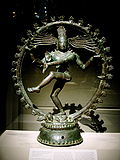This article needs additional citations for verification .(March 2017) |
| Shree Rajarajeshwara Kshetram | |
|---|---|
 Rajarajeshwara Temple | |
| Religion | |
| Affiliation | Hinduism |
| District | Kannur district |
| Deity | Shiva |
| Governing body | Malabar Devaswom Board [1] |
| Location | |
| State | Kerala |
| Country | India |
| Geographic coordinates | 12°2′54.17″N75°21′20.1″E / 12.0483806°N 75.355583°E |
| Architecture | |
| Type | Kerala Architecture |
| Creator | Parashurama |
| Inscriptions | Malayalam |
The Rajarajeshwara Temple is a Hindu temple in Taliparamba, Kannur district, Kerala, India, dedicated to the Hindu deity Shiva. It is one of the 108 Shiva Temples of Kerala and one of the Dwadasha Shivalayam (12 important Shiva temples of ancient Kerala, stretching from Gokarnam to Kanyakumari). It also has a prominent place amongst the numerous Shiva temples in South India. [2] It had the tallest shikhara amongst the temples of its time. The Rajarajeshwara temple has a top of about 90 tonnes.
Contents
Legendarily, it was supposedly renovated by Sage Parashurama, long before the Kali Yuga commenced. Several centuries ago, it was renovated by the Mushika (Kolathiri) dynasty kings. This temple was rebuilt into its present form in the early eleventh century. The quadrangular sanctum has a two-tiered pyramidal roof; in front of the sanctum is the namaskara mandapam, but the temple has no kodi maram (flagstaff), unlike others in Kerala. Only Hindus are permitted to enter. [3]


